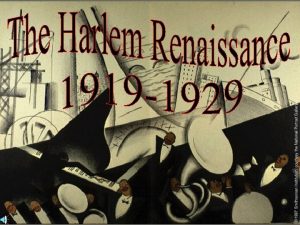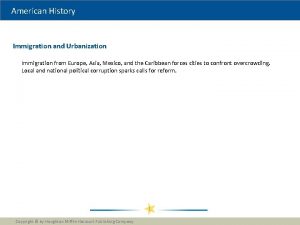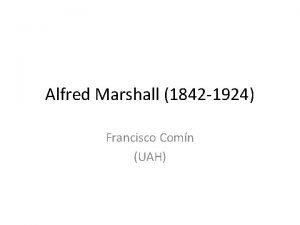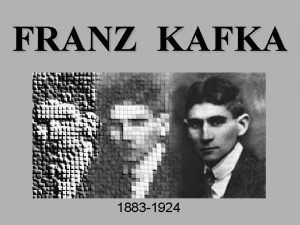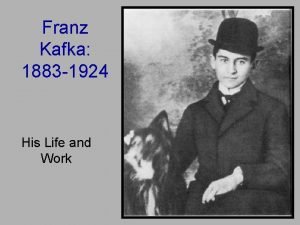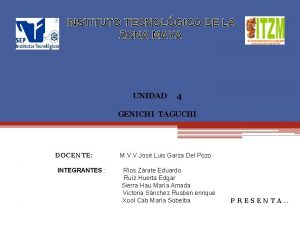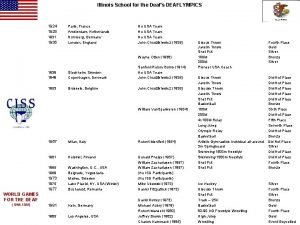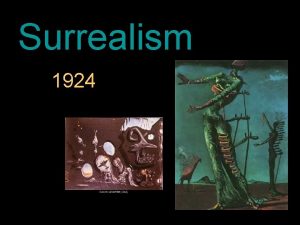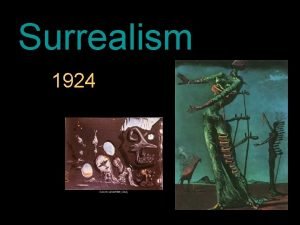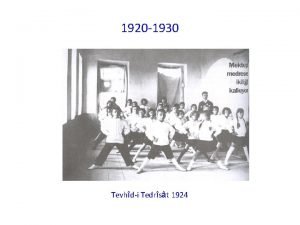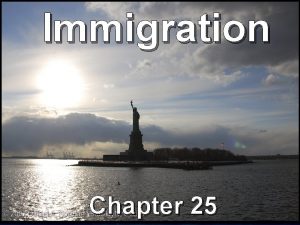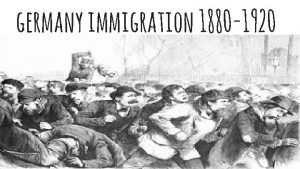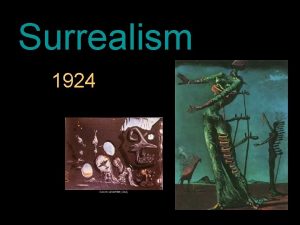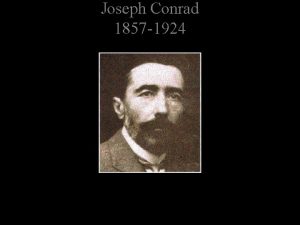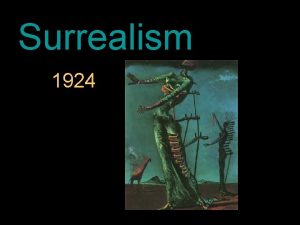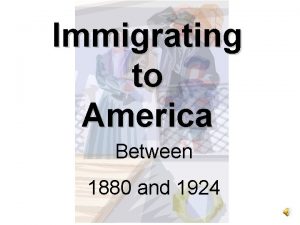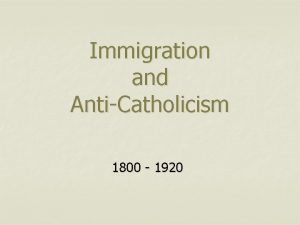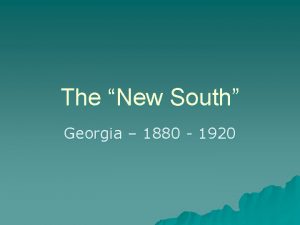New Immigration 1880 1920 Immigration 1880 1924 More

























- Slides: 25

New Immigration 1880 -1920

Immigration (1880 -1924) • More immigrants arrived in the country than ever before during this time period. • New sources of immigration 1. Italians 2. Chinese 3. Russian/Eastern European/Jewish

Reasons for Emigration • Negative reason: Conditions in the home country were so bad they could no longer be tolerated • Positive reason: Conditions in the United States were likely to be better than those close to home • Population pressures: Europe became overcrowded in the Industrial age and there was insufficient farmland to support the people-this was especially true in Italy, Sweden, and Norway • Recruitment campaigns: RR companies with land to sell, mining companies in need of workers, factories recruiting cheap labor, gave the impression that after a few years of work, everyone could be rich in the US and offered discounted steamship tickets to NYC

Practice Multiple Choice Until the early 20 th century, few restrictions on immigration to the United States existed primarily because (1) industry needed an increasing supply of labor (2) immigration totals had always been relatively low (3) labor unions had always favored unrestricted immigration (4) the Supreme Court had ruled that Congress could not restrict immigration

Immigrant’s life in the US • Labor needs- many Europeans thought that factory jobs in the US might be easier to find and be better paying • Liberty and Freedom- Jews in Russian and Poland face pogroms , many eastern European countries had mandatory military service for boys as young as 15 • Ghettos- immigrant groups in this time period tended to live with their own nationality. They lived in poorly built and kept tenements • Americanization- Some immigrants had a more difficult time becoming Americanized • Religion and culture- new immigrants were Catholic, Eastern Orthodox, and Jewish while most of the American population was Protestant.

Ellis Island, NY

Angel Island Asian Immigration

Asians are excluded • In the 1870’s there was talk of Asians coming to the US by the millions and taking over the country. Anti Chinese riots broke out in western states and territories in fear of the “yellow peril” • Two laws were passed in response to nativist fears and prejudice 1 - The Chinese Exclusion Act (1882) 2 - The Gentlemen’s agreement (1907)

Practice Multiple Choice Question One way in which the Chinese Exclusion Act(1882) and the Gentlemen’s Agreement (1907) are similar is that they (1) reflected nativist attitudes in the United States (2) encouraged a policy of popular sovereignty (3) led to an increase in Asian immigration (4) eased requirements for citizenship

Chinese Immigration (1849 -1882) • The discovery of gold in California resulted in an enormous increase in Chinese immigrants coming to make their fortunes. • Chinese immigrants were met with hostility and were barred from owning property or becoming citizens. • Despite this, the Chinese were essential to the development of the Un

Thomas Nast • Thomas Nast was a political cartoonist in the late 19 th early 20 th century. The title of this cartoon is “E Pluribus Unum (except the Chinese)”

Assimilation, the “Melting Pot”, and Cultural Pluralism “tossed salad” • 1. 2. 3. To what extent should immigrants be expected to adopt the customs and language of the American majority? Btwn the years of 1901 -1910 3 views Total Assimilation: immigrants should learn to speak English quickly and shed all remnants of their old country as quickly as possible. “Melting-Pot”: immigrants from various nations will gradually and naturally blend into a single nation-The American nation. English should be the common language Cultural Pluralism (salad): English speaking cultures are not superior to any other culture. All cultures should be respected and valued. Each ethnic group should continue to speak their own language and maintain their own traditions while adjusting to American society. Many cultural pluralists favor the idea of BILINGUALISM-teaching foreign born children in their own native language until they can learn English.

Nativists did not just target Asians: They didn’t like any foreigners • Economic competition for jobs • Want to protect American culture from foreign influences • Desire to feel superior to others-racism. Nativists often asserted that newcomers from southern and eastern Europe were racially inferior and would produce a class of criminals and paupers • Common fear was that new immigrants would be associated with radical and revolutionary causes

Practice Multiple Choice question Which statement best expresses a common belief among nativists in the late 1800 s and early 1900 s? (1) “Give me your tired, your poor, your huddled masses. ” (2) “The streets are paved with gold. ” (3) “All immigrants strengthen America. ” (4) “America is for Americans. ”

Practice Multiple Choice Question Most nativists of the late 1800 s would most likely have supported the (1) creation of settlement houses to aid new immigrants (2) passage of the Chinese Exclusion Act (3) continuation of the contract labor system (4) assimilation of Native American Indians into mainstream culture

American’s also welcomed immigrants • Emma Lazarus “…Give me your tired your poor; Your huddled masses yearning to be free, The wretched refuse of your teeming shore. Send these, the homeless, tempest-tossed, to me, I lift my lamp beside the golden door. ” Lazarus’ poem was inscribed at the base of the Statue of Liberty.


Literacy Testing • Many lawmakers in Congress favored the passage of a Literacy Test • Designed to limit immigration this test would limit any immigrant who couldn’t read in any language from coming into the country. • President Woodrow Wilson vetoed the bill in 1917, but Congress overrode the veto and it became law.

Red Scare 1919 and 1920 • The Communist Revolution in 1917 fueled nativist fears about the loyalties of the foreign –born population • There were concerns that foreign-born radicals might try to overthrow the government • Attorney General A. Mitchell Palmer organized a series of raids Palmer raids to arrest and deport immigrants suspected of disloyalty. • People’s homes, businesses, and offices of political groups were searched by federal agents often without search warrants. • By the time the raids were over, nearly 600 people were forced to leave the US as unwanted “Reds” (radical thinkers

Sacco and Vanzetti case • 1921, Niccolo Sacco and Bartolomeo Vanzetti had been convicted of robbery and murder in Massachusetts. • The evidence against the two men was very weak and they had strong alibis. The judge was biased against them. • The prejudice against the two men was very strong because both were Italian immigrants. • Despite protests and appeals the men were executed in 1927

Quota Acts of 1921 and 1924 • Antiforeign attitudes were reflected in these acts • The Emergency Quota Act of 1921 limited the yearly migration from any country to just 3% of the number arriving from that country in 1910 • Immigration Restriction Act 1924 limited yearly immigration from any country to just 2% of the number arriving from that country in 1890 • These pieces of legislation were directly aimed at limiting to a bare number the immigrants from southern and eastern Europe. • The laws did in fact drastically reduce immigration to the United States.

Practice Multiple Choice A major goal of the immigration acts of the 1920 s was to (1) allow unlimited immigration from Southeast Asia (2) assure equal numbers of immigrants from all nations (3) favor wealthy and well-educated immigrants (4) use quotas to limit immigration from southern and eastern Europe

Immigration Act of 1965 • 1. 2. 3. 4. • The quota system was ended. President Lyndon B. Johnson signed the law. No more than 20, 000 from any one country No more than 120, 000 from countries in the Western Hemisphere No more than 170, 000 from the Eastern Hemisphere Preference given to skilled workers and professionals and to those with family ties in the United States But, now there was a problem with “illegal” immigration

Immigration Reform and Control Act 1986 • Increased problem of illegal immigration in the 1980’s caused a call for greater monitoring and control of US borders • This act increased the sized and scope of the US border patrol service as well as streamlining the process of deportation of illegal immigrants. • The law also punishes employers who knowingly hired illegal immigrants but provided limited blanket amnesty for illegal immigrants who have been living in the US since 1982 or prior

President Obama’s Immigration policy • President Obama gave relief to undocumented young people (under the age of 31) who were brought to the United States illegally by their parents. • These young people are allowed to apply for legal status through the Homeland Security Department • Congress is still wrangling over immigration policy, with new pieces of legislation being introduced. One such proposal is called the DREAM Act. It has yet to pass both houses of Congress.
 More more more i want more more more more we praise you
More more more i want more more more more we praise you More more more i want more more more more we praise you
More more more i want more more more more we praise you Map of harlem nyc
Map of harlem nyc Strengths of articles of confederation
Strengths of articles of confederation Neil thisse is a loyalist answers
Neil thisse is a loyalist answers Immigration and urbanization new technologies lesson 4
Immigration and urbanization new technologies lesson 4 Old vs new immigration
Old vs new immigration O artesão - vicente do rego monteiro
O artesão - vicente do rego monteiro 1924-1953
1924-1953 Alfred marshall (1842-1924)
Alfred marshall (1842-1924) The assistant chapter 2
The assistant chapter 2 1883-1924
1883-1924 1924-1883
1924-1883 A wise economist asks a question meaning
A wise economist asks a question meaning Anong panahon naimbento ang balagtasan sa pilipinas
Anong panahon naimbento ang balagtasan sa pilipinas Marxists.org
Marxists.org 1924 stalin becomes soviet dictator
1924 stalin becomes soviet dictator 1924-1883
1924-1883 Reichsjugendwohlfahrtsgesetz 1924
Reichsjugendwohlfahrtsgesetz 1924 1923 1924
1923 1924 Genichi taguchi (1924-2012)
Genichi taguchi (1924-2012) Deaflympics 1924
Deaflympics 1924 1924 summer olympics
1924 summer olympics Characteristics of surrealism
Characteristics of surrealism Persistence of memory art style
Persistence of memory art style Mayos motivation theory
Mayos motivation theory


